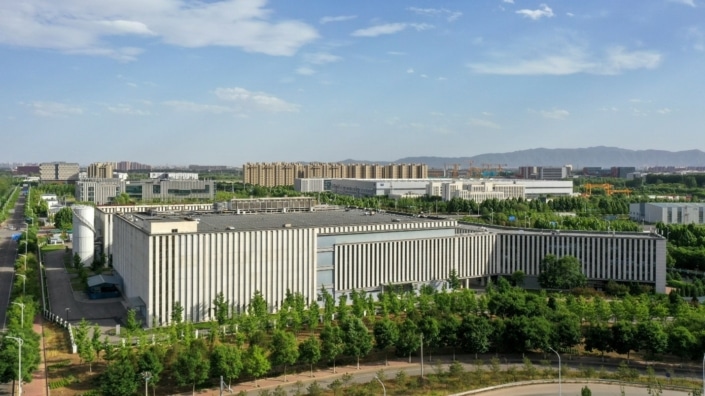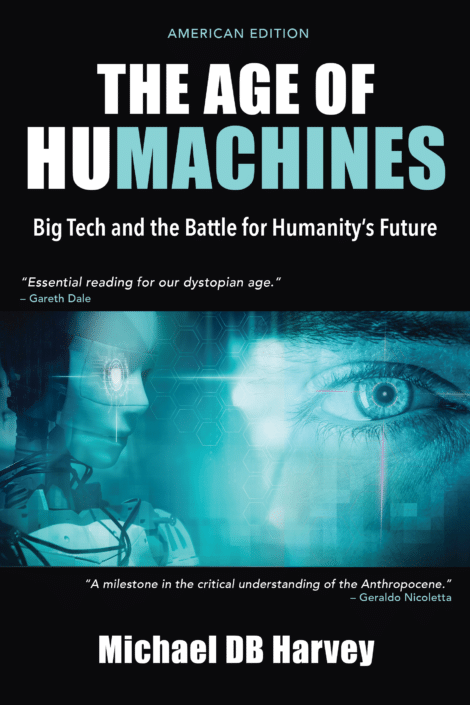Is it just our filter bubbles? Or is an understanding of the environmental impact of artificial intelligence (AI) slowly making its way into the mainstream? Recently, a spate of news stories have highlighted the hefty environmental footprint of AI. Take for instance this recent article by the Washington Post on the hidden water footprint of using AI chatbots. Or this article by The Guardian on how the greenhouse gas emissions of data centers may be almost eight times higher than large technology companies like Google or Microsoft will acknowledge.

What it really takes to store our data: Physical infrastructure of a National Petroleum Corporation data center in China (Charlie fong, Wikimedia).
One particular story I’d like to highlight here, however, is a four-minute segment from NPR’s All Things Considered. The story reports on the negative environmental and health repercussions of a recently unveiled datacenter in Memphis. The facility is slated to provide massive computing power to Elon Musk’s latest AI project: a chatbot “with a sense of humor,” christened “Grok.” Grok is a word coined by science fiction author Robert A. Heinlein to mean “to understand profoundly and intuitively.” In Musk’s own words, he intends it to become “the most fun AI in the world.”
There are two reasons that this story stood out to me. Firstly, it offers an especially stark juxtaposition between Big Tech entrepreneurs’ lofty AI visions and their on-the-ground, real-world implications. Musk explains the aim of Grok is to be “fun” and to “understand the universe.” But on the ground, this translates to generators burning methane gas without environmental permits in a community already afflicted by high rates of asthma and low life expectancy.
The second reason the story caught my attention is that it highlights the undemocratic nature of the land allocation process that the project relied on. The company did not brief environmental agencies, city council, or community members before opening the facility. Memphis Councilwoman Yolanda Cooper-Sutton reports she learned about the facility opening through the local news.
This rushed and secretive way of proceeding is by no means a feature unique to Musk’s latest AI project. Rather, it is a ubiquitous part of the industrial land permitting process in the United States. The information industry as it exists today is heavily reliant on this secretive and undemocratic process. It may like to portray itself as progressive and cutting-edge. But it depends for its existence on a playbook as old as the country—in many ways much older.
Nothing New Under the Sun
The information industry is plowing the same furrows that the fossil fuel industry dug before it. Steven Stoll, in his history of the successive land dispossessions that allowed the transfer of land first from Native Americans to European settlers, and then from these settlers to the coal industry, explains how key the theft and destruction of land was to fashioning a new industrial economy. Without the destruction of what Stoll calls the homesteaders’ “ecological base” (the commons that they relied on to sustain their agricultural way of life) through logging and then coal mining, farmers could not have been pried away from their land and absorbed into the wage labor economy. The capture of this labor pool was key to industrializing the economy.

A long history of land dispossession: The Creek People on the Trail of Tears (Photograph of a painting at the Ocmulgee monument by TradingCardsNPS on Flickr).
Brian Czech made a compelling case in Supply Shock that the continued pursuit of economic growth cannot be uncoupled from the unsustainable exploitation of land for agricultural and extractive activity. The window Stoll provides into the role of land expropriation in creating industrial economies makes Czech’s conclusion even more alarming. Basically, where we find high-intensity agriculture, we should also expect wanton destruction of land for natural resource extraction. Since the rise of the digital age, much of this destruction is for powering our “information economy.”
In the early days of American history, this pattern of land dispossession was often accompanied by violent conflict. Today, this has mostly given way to legal and regulatory instruments. These include zoning laws, which build on the destructive legacy of redlining. (Redlining was the historical legalized exclusion of black people from “high-value” neighborhoods during the Jim Crow Era.) These instruments also include federal and state land permitting processes. Freeing land up for industrial development is not so much about forcing people off their land anymore. Rather, it is about trapping them on land that the industry is free to poison with impunity.
If you take the time, like I have, to study these sites of industrial land appropriation, you will probably conclude that the business of destroying our environment and hollowing out our rights are two sides of the same coin. This is the legacy that Elon Musk’s Grok builds on, along with the rest of the AI revolution. It draws us in with ethereal images of wispy cloud computing. But behind that façade, all we’re getting is an extra serving of whirring factories and trucks and smokestacks. And along with it, its attendant violations of our ecological integrity and human rights.
Debunking the AI Industry’s “Green Growth” Narrative
Unlike the fossil fuel industry, our information industry has so far managed to hold its legacy of environmental destruction and human rights violations at arm’s length. You don’t have to look further than Elon Musk to illustrate this point. Recall the time before the public relations disaster of what I’d like to call “ex-Twitter.” Around the time his electric vehicles hit the market, Musk was able to effortlessly position himself as the great decarbonizer of the private transportation sector. This was despite his simultaneous allocation of vast amounts of natural resources to his AI and space exploration ventures.
Unlike the fossil fuel industry, the information industry has a compelling story to sell us. As Big Tech proponents purport, and our media system amplifies, the creation of AI will help us unlock the technological efficiencies necessary for green growth.
It is easy to understand why this argument is seductive. AI, even in its current larval stage, functions in many ways beyond the realm of human comprehension. It even extends beyond the comprehension of the engineers who develop it. Take Sebastian Bubeck, for example, a Microsoft engineer for GPT4 who was tasked with testing the new AI. Bubeck knew that GPT4 was trained exclusively on text. So he came up with the idea of asking the AI to draw a unicorn using an obscure coding language. GPT4 succeeded, but Bubeck has no idea how. If AI can draw unicorns without us knowing how, the reasoning goes, perhaps it can also solve complex problems we don’t know how to solve. Problems like climate change.

The Magic Dream Cloud (Basile Morin, Wikimedia).
However, as the mainstream media is finally beginning to acknowledge, AI is a technology like any other. And technology has an inherent ecological footprint. In other words, AI does not escape the fundamental truth governing all technological progress. It cannot be pursued without consuming natural resources. And the efficiencies that our R&D industry unlocks cannot offset the environmental devastation associated with our rate of economic growth. It doesn’t help that with digital technology, from AI and cloud computing to cryptocurrency, the resources consumed are massive. To quote NPR’s supercomputer story, “AI requires more electricity to complete even simple tasks compared to typical search queries.” And in the United States, “about 60% of that electricity comes from burning fossil fuels.”
The story we are fed is that AI can unlock untapped cognitive resources to solve our environmental crisis. But more than likely, it will only compound this crisis, by adding an environmentally destructive dependence on information to our current environmentally destructive dependence on cheap energy. Which brings us back full circle to the information industry’s adoption of the fossil-fuel playbook of government-sanctioned, undemocratic, massive, and secretive theft of land and natural resources.
Why Environmentalists Should Care About Big Tech
Until recently, public anxieties surrounding AI and human augmentation have largely ignored its ecological impact. Instead they tend to focus on the potential advent of the “singularity” or on more immediate problems like the deskilling of our college students and the gutting of our creative and white-collar professions. This may have lulled the more ecologically minded among us into ignoring the environmental toll of AI. But that doesn’t make it less real.

This environmental toll is one of the core focuses of Michael DB Harvey’s book The Age of Humachines, the American edition of which will be published under the Steady State Press imprint next month. Harvey manages to make accessible to the general public ideas that previously seemed exclusive to obscure academic fields like critical data center studies. I opened this article by commending the mainstream media for taking on the ecological footprint of the information industry. I also want to express my heartfelt appreciation for Harvey’s effort to bring the potential human and environmental casualties of what he calls the “Humachine Revolution” into the mainstream.
The Age of Humachines is essential reading for anyone wanting to cut through the human progress narrative that Big Tech entrepreneurs have been spinning around their corporate greed. It offers a timely exploration of the environmental destruction and the democratic hollowing central to the humachination agenda.
In Humachines, Harvey argues that the preservation of our natural environment and of our “indigenous capacities” (skills such as wayfinding, political decision-making, and caring for the community) are two prongs of the same goal. Keeping both in mind are key to steering clear of the Big Tech vision of what Harvey calls the “Technocene.” Instead, Harvey advocates for a future—the “Ecocene”—where we collectively determine the use of our technologies. The weakening of democratic control has always been a necessary ingredient for widespread ecological exploitation under capitalism. Bolstering democratic power is likely to be an effective and underappreciated means of slowing down or reversing land exploitation.
Striving Toward the Ecocene
Harvey closes his book by arguing for a different kind of utopia. He paints a vision for a future “that regards the Enlightenment goals of democracy and social equality as much more than political rhetoric.” It would be a future where we could continue to cherish the gifts that human technology and science have bestowed upon us. But we would also have the skills and the power to recognize when “enough is enough” (p.430).

“Ecocenery”–no data overload (Greg_FOT, Flickr).
What would it look like if we applied the Ecocene playbook to the siting process of Musk’s supercomputer in Memphis? To begin with, public officials, environmental agencies, and the community would be notified long before a single molecule of industrial by-product was released. They would have the opportunity to weigh in before a single drop of water or joule of electricity was consumed. Musk’s plan to site his facility near a community with a history of industrial exposure would also be scrutinized. But that would just be the beginning.
Decisions driving the allocation of land for technological development could be placed in the hands of affected communities. Steering committees could be selected from these communities using a process similar to jury selection. These committees would have the power to make binding decisions about the proposed land development. More broadly, no permitting process for an industrial development would be considered legitimate unless the permit was issued through a democratic process involving the parties concerned. No article could get published framing a Big Tech entrepreneur’s and the affected community’s position on a proposed industrial project as equivalent. Because the truth, Harvey argues, is that decisions about technological progress should be made collectively. We are all inheritors of the decisions of the engineers of the Humachine Age. It’s time we take back the reins.

